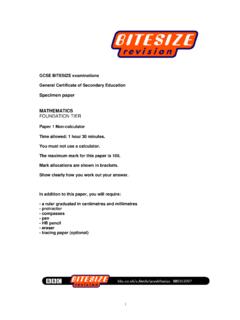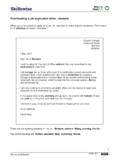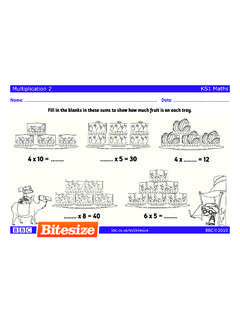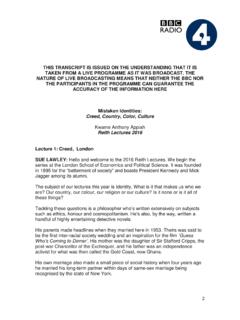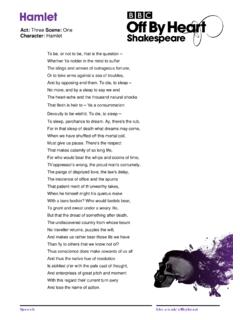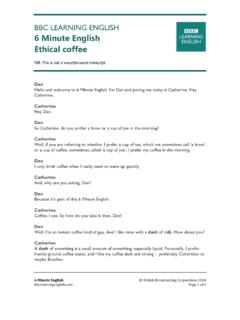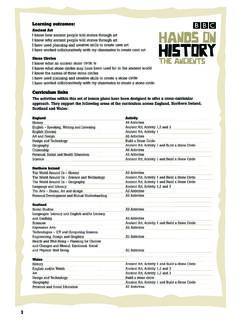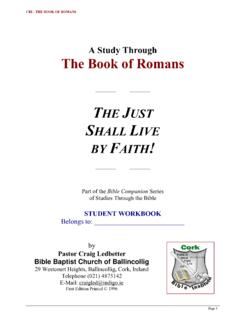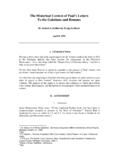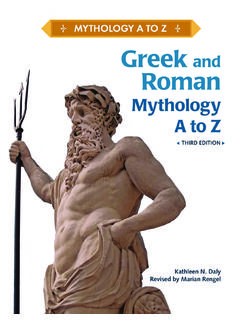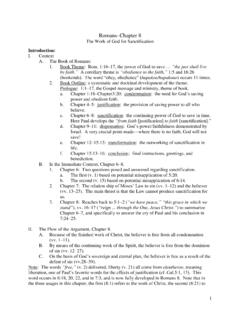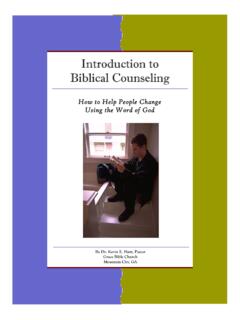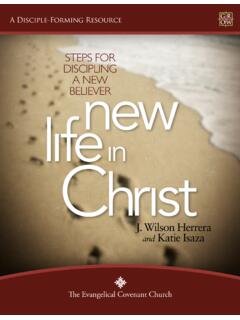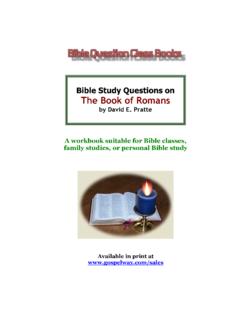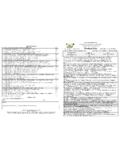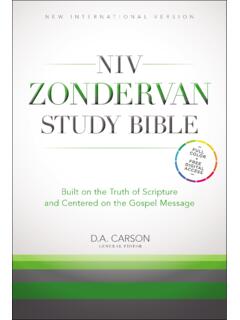Transcription of School Radio - BBC
1 RomansSchool Radio BBC RadioAge: 7 - 11 Audio online:These programmes are also available to listen to online as steamed audio from the BBC iPlayer Radio . Go to this url: Teacher s Notes are primarily intended for print. The content - with additional features - can also be found on the Romans pages of the website pages include online versions of images, which can be displayed on your IWB or computer while listening. Titles that appear in blue have been hyper-linked to the relevant pages of the website, allowing convenient navigation from these notes to the web pages. IntroductionThe content in this series gives 7 to 11 year-olds a rounded view of the Roman invasion and settlement of Britain. In Roman character sketches pupils glimpse daily life under the Empire. The three-part drama Boudicca brings to life the bloody tale of the Roman invasion.
2 And pupils can enjoy the lighter side of life under the Romans with the Romans in Britain comedy sketches. Each content section comes with activity notes to explore its themes more fully in the classroom. Pupils are invited to imagine and investigate the period and to conduct their own historical links: links to useful websites are provided throughout. But please note that the BBC is not responsible for the content of external websites. This publication contains only BBC copyright material: its contents may be copied or reproduced for use in schools and colleges without further s Notes written by Martin Malcolm2 School Radio BBC RadioHistory Clips: The RomansSchool Radio BBC RadioSchool Radio BBC RadioContentsThe Romans content is available as audio on demand from the BBC iPlayer. Roman character sketches 31.
3 The Centurion 4 Audio begins The Slave 8 Audio begins The Lady 12 Audio begins 164. Queen of the Iceni 17 Audio begins Boudicca s victories 19 Audio begins 6.
4 The final battle 21 Audio Begins Comedy sketches - The Romans in Britain 23 7. Romans, Britons and invasion 24 Audio begins The Roman army and British resistance 26 Audio begins How the Romans changed Britain 28 Audio begins How the Romans lived in Britain 30 Audio begins Romans pastimes and customs 32 Audio begins The Roman legacy 34 Audio begins Radio BBC RadioHistory Clips: The RomansSchool Radio BBC RadioHistory Clips: The RomansSchool Radio BBC RadioSchool Radio BBC RadioRoman character sketchesIntroductionThree characters describe everyday life in Roman Britain.
5 The CenturionCornelius, a veteran centurion at work on Hadrian s Wall, dreams of the day he ll retire. He guides us through a punishing round of skirmishes and the hard graft of endless repairs to the crumbling wall. His story gives a vivid insight into the human cost of maintaining an SlaveNicia, a Briton and a slave, gives us a tour of the fine villa she works in. She has no illusions about her lowly place in the Roman world, but she s proud all the same of the finery she shows off. Her story hints at the complex relationships that grew up over time between the rulers and the LadyClaudia, the wife of the new magistrate of Noviomagus (modern-day Chichester) is planning a party to celebrate her husband s promotion. There s the menu to choose, the flowers to arrange, the entertainment to organise, the slaves to s a busy day for an ambitious hostess.
6 Claudia is very conscious that neither she nor her husband Aelius are Romans. In fact, they re descended from the very tribes that fought them. Now though, things are very different. Claudia s ready to embrace the Roman way of life and all the opportunities it offers. Her story illustrates how Britons and Romans increasingly mingled over the long years of Your pupils could use these Notes to explore the themes of Roman character sketches in the class-room. The Notes provide opportunities for children actively to imagine and investigate the period and to conduct their own historical Radio BBC RadioHistory Clips: The RomansThe Centurion We march, set up camp and repair, march, set up camp and repair, march, set up camp and, well, you get the Find out more about the life of Cornelius the centurion, battling Barbarians and bad weather on Hadrian s mappingSubjects: history, geography, information could ask pupils, How do we know about the Roman conquest of Britain?
7 In reply, they might mention history books, artefacts, accounts from the time and archaeological remains. Encourage pupils to find the Antiquities section on the key of an Ordnance Survey map. Choose a local map, if you live in a part of the country with a lot of Roman remains. Otherwise choose a map of the area around Hadrian s Wall, or near to another well-known Roman settlement - Chichester, perhaps, or St key has symbols for Villa and Tumulus (a burial mound of an Ancient Briton chieftain), battle-fields, monuments and other positions of antiquity . Pupils could work in pairs to search sections of the map for these features. How many can they find? Are their finds clustered? What might such clusters suggest? Pupils could compare maps from different locations in Britain. Why do the children think some areas are richer in Roman remains than others?
8 5 School Radio BBC RadioHistory Clips: The RomansSchool Radio BBC RadioHistory Clips: The RomansPupils could use online mapping sites and internet searches to capture images of their of warSubjects: history, art, information technologyCornelius mentions a number of Roman weapons: the onagar, the ballista, the spear and the short sword. Pupils could search a variety of sources, including books and websites, for images of these weapons. They could look too for other military equipment, such as shields. The children could sketch their finds and draw their impressions of what Cornelius and his men might have looked like. Can pupils work out what each weapon would have been good for? For instance, which weapon would you choose to tackle a horseman? Which weapons would be hard to use in a confined space?The children could collect their found images, photos and sketches into a digital slideshow.
9 They could record a soundtrack to accompany the slideshow, in character as Roman soldiers, or their slaves, living on Hadrian s Wall. This commentary could give advice on how to use or maintain each of the items marchSubjects: history, PE, mathematicsOur word mile comes to us from the way Roman armies measured the distance of their marches. The Latin phrase mille passum means one thousand paces . When a Roman legionary had taken one thousand steps, he d covered a mile. You could ask pupils to estimate how long it would take them to march a Roman mile. Individuals could try marching on the spot, while a friend counts their paces and another classmate times how long it takes. Alternatively, if you have a pedometer, pupils will enjoy using this to count their steps. (Pupils could march a hundred steps and then multiply their time by 10 to arrive at their mile times.)
10 The class could go on to work out an average speed for a mile march, based on their individual scores. Based on this information, how many miles could they march in one hour? And how easy do they think it would be to keep up a fast pace? From their research, how long do they think it would have taken for a soldier to march the length of Hadrian s Wall (73 miles)? How many times do they think the soldier will need to stop and rest?The children could go on to convert their miles-per-hour scores into Radio BBC RadioHistory Clips: The RomansRoman reportSubjects: English, history, modern foreign languagesThe website of the Vindolanda Fort and Museum has photos of Hadrian s Wall and of Roman writing tablets discovered nearby. These thin strips of wood are covered in spidery handwriting from 2,000 years ago. Romans living along the wall wrote letters home, which were carried by messengers to places all over the would have sent regular reports to his commander.


